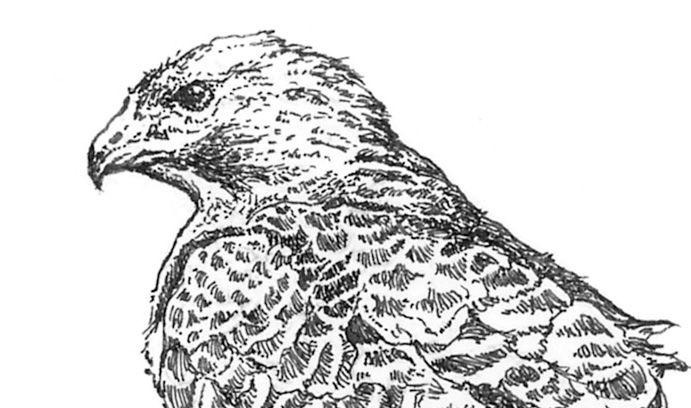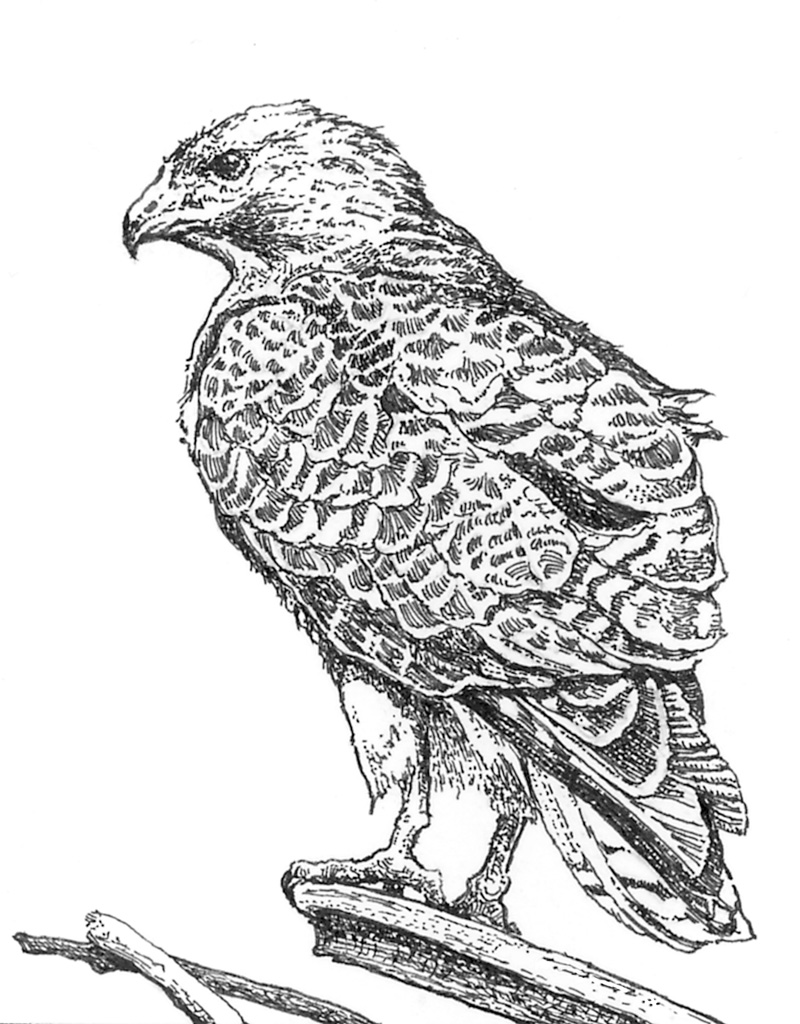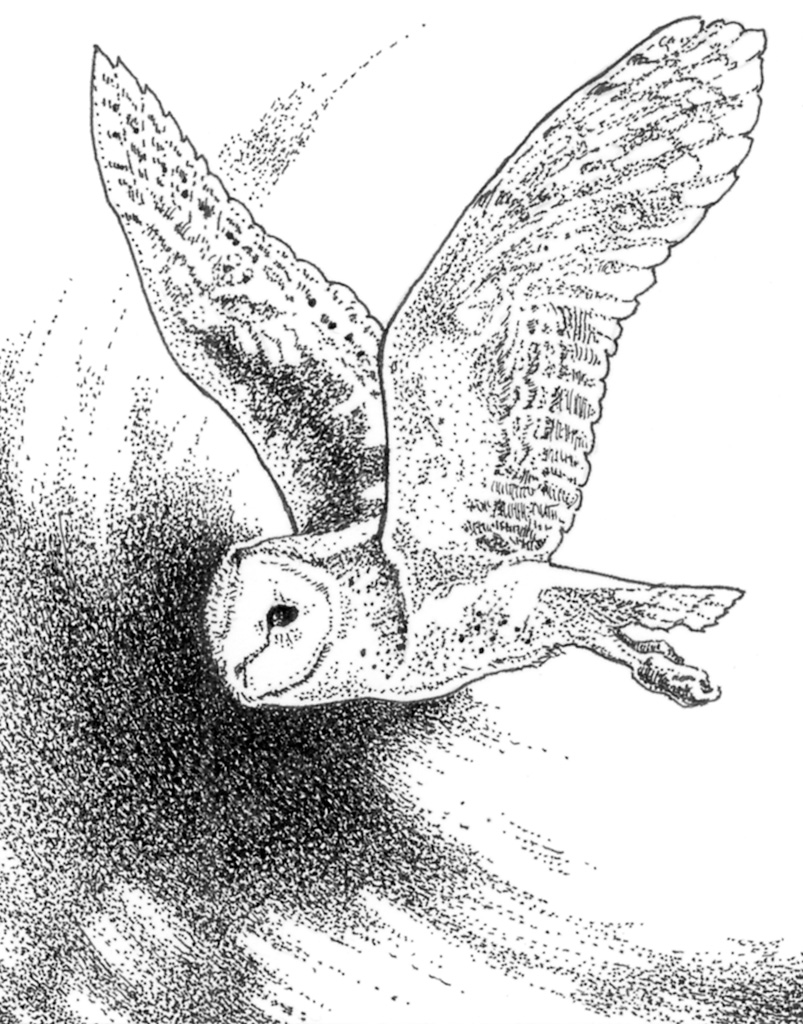
Garden Allies: Raptors

Contributor

Powerful Winged Hunters
Standing in our narrow side yard, my husband and I were startled by the sudden arrival of a red-tailed hawk scooping up a snake less than fifteen feet away. It seemed a rare experience, but a quick, informal survey of other gardeners revealed many a close encounter with a backyard raptor. Sharing curved talons for capturing and hooked beaks for tearing apart prey, raptors vary in size, general appearance, and life histories. They are generally well camouflaged, and can be hard to spot unless in flight.
True falcons, such as American kestrels and peregrine falcons, are in the genus Falco, but a few raptors share the common name “falcon” for their streamlined appearance and long wings. “Hawk” is a general term that refers to all raptors other than vultures, falcons, and owls, while “eagle” usually indicates a large hawk. Owls are unrelated to other raptors—an example of convergent evolution, where unrelated species have evolved to fill similar ecological niches. Nocturnal owls and diurnal raptors avoid competition by hunting at different times of day. Roadrunners and other meat eaters are birds of prey but not raptors, as they use their beaks to capture their prey.
A Sign of Ecological Health
Raptors play significant roles in many ecosystems, and serve as good indicators of ecological health. In addition to talons and sharp, hooked beaks, they have superior eyesight and, in the case of owls, exceptional hearing. Many raptors travel great distances from wintering grounds to breeding grounds; the Pacific Flyway offers several prime spots to view rare species that are unlikely to be seen in urban landscaped settings.
Raptors’ body forms reflect hunting strategies and prey preferences. Kites are well known for “kiting” or hovering in one spot. Many large raptors soar, diving down upon prey from the air; falcons can dive at tremendous speeds. Some raptors course rapidly over low ground, while others are slow-moving searchers; red-tailed hawks practice still-hunting (perching and waiting to sight prey). Owls rely on hearing; the facial disc they possess serves to focus sound on their asymmetrical ears, as they fly silently through the night. Hunting style is one determinant of the likelihood of garden visits, and some strategies are incompatible with even large gardens.

Prey Types
Some raptors are highly specialized, reliant on a single or a few prey species for survival (eg, some kites prey only on snails, and osprey eat fish), but most raptors have a broader diet that allows them to survive more easily when prey is scarce. White-tailed kites eat primarily mice and voles, while sharp-shinned hawks and Cooper’s hawks prey primarily on songbirds. Red-shouldered hawks and red-tailed hawks prefer rodents, but they will eat many other small animals. American kestrels eat insects, including grasshoppers and crickets, and may take small birds. Peregrine falcons mainly catch birds on the wing. Barn owls primarily hunt rodents, Western screech-owls take many small animals, including insects, and great horned owls eat a broad diet of mostly mammals.
More raptor species, especially in breeding populations, are found in California than in more northerly Pacific Coast climes; white-tailed kites are found year-round in California and Oregon but have spotty distribution in Washington. On the other hand, some are more northerly, such as the Northern goshawk. Some raptors, such as peregrine falcons, are cosmopolitan (world-wide). Great horned owls range far into Alaska, and Western screech-owls just into Alaska; barn owls are found throughout the West, but just into Canada.
Habitats and Nesting
Many raptors are shy of human contact and have suffered declining populations due to habitat destruction. Others are still recovering from the devastating effects of DDT. However, some raptors (Cooper’s hawks, peregrine falcons, and Western screech-owls) have adapted to human habitats and may nest in urban and suburban environments, where prey can be plentiful. In the wild, raptors like a variety of habitats, from riparian areas, cliffs, or open ground to coniferous and deciduous forests. Nests may be hidden in tree crowns, on ledges, and in cavities; many raptors prefer specific kinds of trees for nests. Some raptors do not build nests at all, instead using hollows or the abandoned nests of other birds.
Most raptors require trees and other tall objects for nesting, but barn owls can be successfully attracted to nesting boxes as low as eight feet off the ground. One family of barn owls may result in the control of over 3,000 rodents in a single season, so a box is a wise investment for any gardener plagued by gophers. What a thrill it is to hear the arrival each spring of the red-tailed hawks that nest in a neighbor’s towering eucalyptus tree, and to hear the resonant hoot of the great horned owls that nest on another’s property. It will be a pleasure to add a barn owl box to our garden and listen for the sounds of a nesting pair; their help in controlling rodents will be priceless.

In a Nutshell
Popular Name:
Birds of prey and some carrion feeders are collectively known as raptors. Raptors include falcons, kites, osprey, harriers, accipiters, and buteos (Order: Falconiformes), and owls (Order: Stringiformes).
Scientific Names:
North American members of Falconiformes include 34 species in 19 genera. Accipitridae: white-tailed kite (Elanus leucurus), sharp-shinned hawk (Accipiter striatus), Cooper’s hawk (A. cooperii), Northern goshawk (A. gentilis) red-tailed hawk (Buteo jamaicensis), red-shouldered hawk (B. lineatus). Falconidae: American kestrel (Falco sparverius), peregrine falcon (F. peregrinus). North American members of Stringiformes include 19 species in 11 genera. Tytonidae: barn owl (Tyto alba). Strigidae: great horned owl (Bubo virginianus), Western screech-owl (Otus kennicottii). This list does not include all raptors that may be occasional or rare visitors to gardens.
Common Garden Species:
Raptors are infrequent garden visitors; most commonly spotted are red-tailed, red-shouldered, and sharp-shinned hawks, but kestrels and owls may also visit.
Distribution:
Many raptors have a wide distribution in Western North America; some may be only seasonal visitors, migrating on the Pacific Flyway.
Life Cycle:
All birds lay eggs, usually in the spring; some may produce more than one brood in a year in some localities. Large raptors often hatch only one or two chicks annually; many raptors return to the same nest site each year.
Appearance:
Winged and feathered with two feet! Raptors have talons (powerful curved claws for catching prey) and hooked beaks for tearing up their catch; owls have forward-facing eyes. They vary greatly in size, color, and general appearance. In most bird families, males are larger than females; the reverse is true of raptors.
Life Span:
Varies widely; generally, larger birds have longer life spans. Eagles may live twenty years or longer, Red-tailed hawks ten to fifteen years, kestrels up to eight years. Some owls, for example barn owls, live only one or two years.
Diet:
Raptors are carnivores and eat rodents and other mammals, reptiles, amphibians, fish, insects, birds, and even other raptors. While a few raptors are specialists, eating only one type of prey, most are fairly indiscriminate.
Favorite nesting sites:
Many raptors favor specific tree species in wooded and riparian habitats; some raptor species may nest in suburban environments. A few, such as burrowing owls, nest on or even under the ground. Some raptors nest in hollows and cavities or on ledges.
Benefits:
Raptors prey on rodents and some insects.
Problems:
Sharp-shinned hawks often take garden songbirds.
Interesting facts:
The raptor’s wild cry heard in films is usually that of a red-tailed hawk. The only predator that regularly eats skunks is the great horned owl.
Sources:
A garden full of life will occasionally attract raptors.
More information:
How Fast Can a Falcon Dive? Fascinating Answers to Questions about Birds of Prey, Peter Capainolo and Carol A Butler (Rutgers University Press, 2010).
Raptors of California, Hans Peeters and Pam Peeters. (University of California Press, 2005). Includes raptors that live in Oregon, Washington, and Western Canada.
Field Guide to Owls of California and the West, Hans Peeters (University of California Press, 2007). Companion to Raptors of California.
https://www.scvas.org/pdf/cbrp/BuildingBarnOwlBoxes.pdf. Barn owls are one of the few raptors that will nest in human-made boxes.
https://www.facebook.com/cornellbirds. A treasure for bird lovers.
See also Birds I, Birds II (Pacific Horticulture, January 2010 and 2011).











Responses